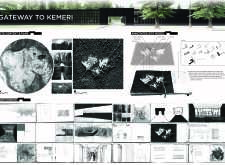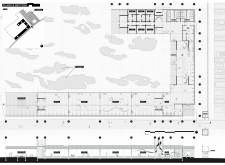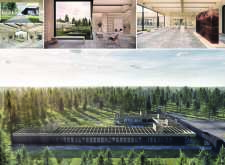5 key facts about this project
## Overview
The Gateway to Kemeri is situated at the entrance of Kemeri National Park, facilitating a vital connection between urban spaces and the expansive natural landscape. The design aims to create an inviting atmosphere that encourages exploration and engagement with the park's rich ecology. By integrating natural elements into the architectural framework, the project fosters harmony with the surrounding environment while serving as a point of interaction for visitors.
## Material Selection
The architectural identity is strongly influenced by the choice of materials, prioritizing sustainability and functionality. Wood is extensively used for its ecological attributes and aesthetic appeal, providing a lightweight and sturdy frame that resonates with the forested context. Concrete forms the structural backbone, ensuring durability and stability, while glass is incorporated to enhance natural lighting and offer views of the landscape, reinforcing the connection to nature. Metal elements, primarily utilized for structural purposes, introduce a contemporary aspect to the overall rustic theme.
## Spatial Organization and Climatic Considerations
The spatial layout effectively organizes functional areas, with public spaces positioned prominently at the front to encourage visitor interaction, while private and support areas are located towards the rear, optimizing movement flow. The design considers seasonal climatic variations through strategic placements of walls and openings, harnessing solar gain in winter and promoting passive cooling in summer. Features such as overhangs create shaded areas, enhancing comfort and reducing energy consumption.
Innovative roof designs incorporate complex geometries that facilitate rainwater capture and contribute to the site's visual character. The project preserves existing trees and applies biophilic design principles, reinforcing the interaction between built forms and the natural environment, ultimately enriching the visitor experience in Kemeri National Park.






















































